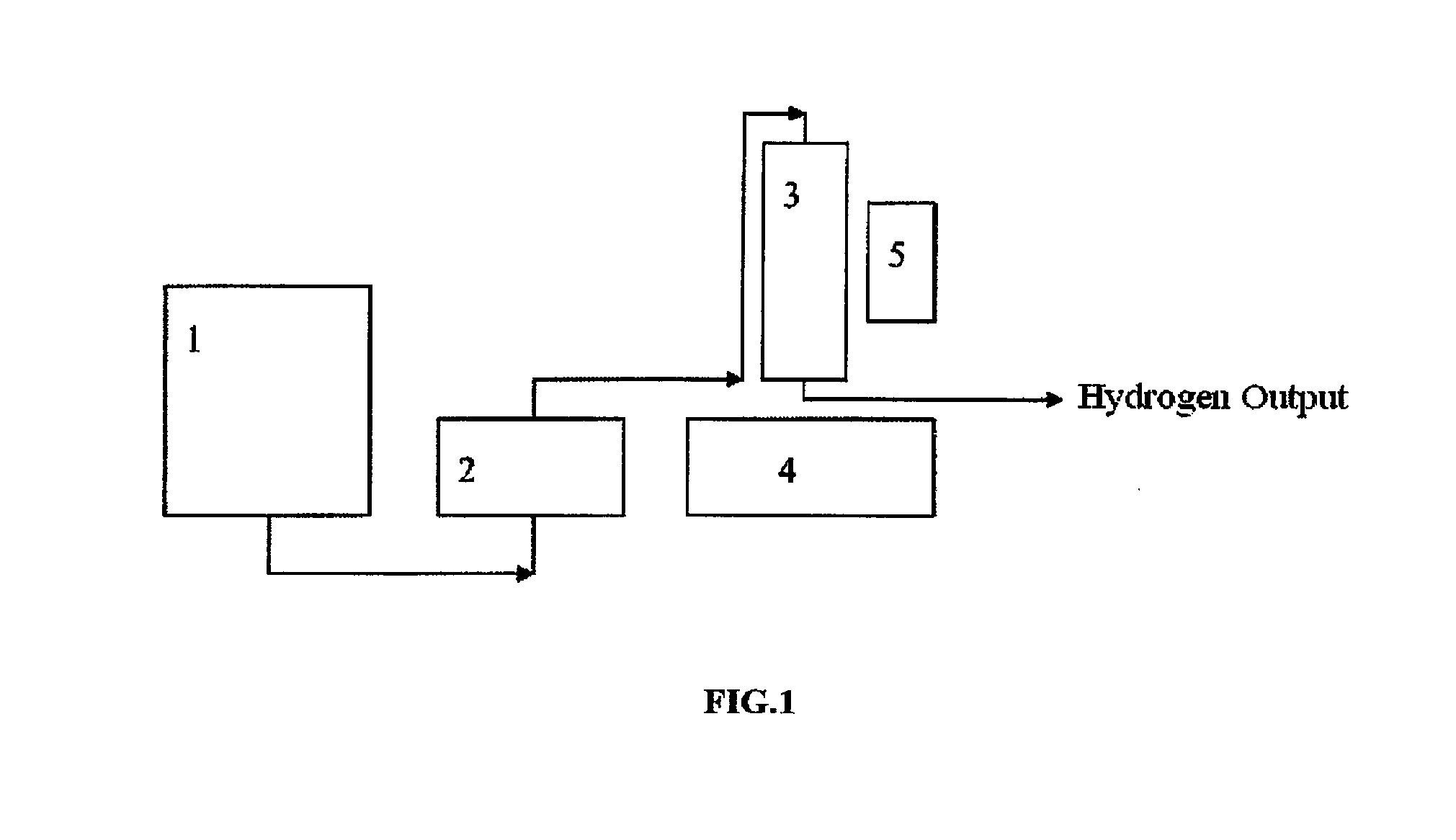Hydrogen generating composition, reactor, device and hydrogen production method
a technology of hydrogen gas and composition, which is applied in the direction of electrochemical generators, other chemical processes, explosives, etc., can solve the problems of increasing complexity, environmental damage, and high cost of the catalyst cobalt chloride used in prior art reference u.s. 61/201,390, and achieves high hydrogen production density, cost-effective, and easy-to-stop-and-restart
- Summary
- Abstract
- Description
- Claims
- Application Information
AI Technical Summary
Benefits of technology
Problems solved by technology
Method used
Image
Examples
embodiment 1
[0063]A composition with a bulk volume of 5.5 cc was prepared by mixing together 1.9 g (about 0.05 Mol) of NaBH4 with a bulk volume of about 4 cc and 0.95 g of Mg(OH)2 with a bulk volume of about 2.4 cc, and was filled in the reactor and compacted to a volume of 5 cc using the rubber piston.
[0064]The temperature of the glycerol was controlled in the range of 130±5° C., and the flow rate of the peristaltic pump was set to 0.01 g / min.
[0065]In a temperature increasing phase before the peristaltic pump was activated, a volume of 195 cc of hydrogen was generated. After activating the pump, hydrogen was produced at an initial rate of about 350 cc / hour, and the rate started to slowly decrease 5 hours later. After the reaction had run for 7 hours, the pump was shut down for 8 hours, and during this period, 135 cc of hydrogen was further generated. Afterward, the reaction was restarted and further ran for 6 hours so that the reaction lasted for a total duration of 13 hours. The experiment wa...
embodiment 2
[0068]A similar experiment as conducted in Embodiment 1 was conducted except that 1.3 g of Mg(OH)2 with a bulk volume of about 3.2 cc was used and a composition with a bulk volume of 6 cc was prepared, and that the composition was not compacted after it was filled in the reactor.
[0069]The reaction produced a total of 4090 cc of hydrogen at an adequacy of 91.3% relative to a theoretical production of 4480 cc.
[0070]The residual product of the reaction had a gross mass of 4.55 g and a net mass of 3.25 g obtained by subtracting the mass of the Mg(OH)2 therefrom.
embodiment 3
[0071]A composition with a bulk volume of about 11 cc was prepared by mixing together 1.9 g (about 0.05 Mol) of NaBH4 with a bulk volume of about 4 cc and foamed plastic pellets with a bulk volume of about 10 cc (the weight of the pellets was too small to be measured), and was filled in the reactor and compacted to a volume of 8 cc using the rubber piston.
[0072]The temperature of the glycerol was controlled in the range of 130±5° C., and the flow rate of the peristaltic pump was set to 0.03 g / min.
[0073]In a temperature increasing phase before the peristaltic pump was activated, a volume of 190 cc of hydrogen was generated. After activating the pump, hydrogen was produced at an initial rate of about 900 cc / hour, and the rate decreased slowly with the proceeding of the reaction. After the reaction had run for 3 hours, the pump was shut down for 8 hours, and during this period, 290 cc of hydrogen was further generated. Afterward, the reaction was restarted and further ran for 3 hours s...
PUM
 Login to View More
Login to View More Abstract
Description
Claims
Application Information
 Login to View More
Login to View More - R&D
- Intellectual Property
- Life Sciences
- Materials
- Tech Scout
- Unparalleled Data Quality
- Higher Quality Content
- 60% Fewer Hallucinations
Browse by: Latest US Patents, China's latest patents, Technical Efficacy Thesaurus, Application Domain, Technology Topic, Popular Technical Reports.
© 2025 PatSnap. All rights reserved.Legal|Privacy policy|Modern Slavery Act Transparency Statement|Sitemap|About US| Contact US: help@patsnap.com

